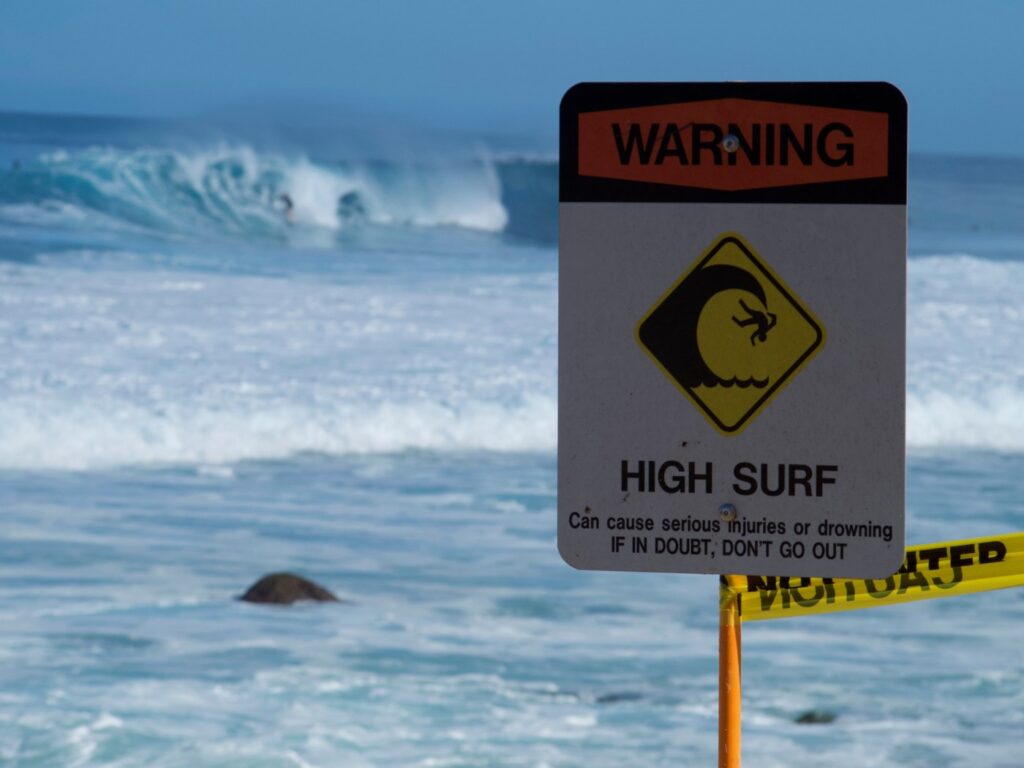
Beachgoing is perhaps the most popular activity among tourists in the Aloha State. The Hawaiian archipelago is noted for beaches of all shapes and colors — from the uniform sugar sand of Ka’anapali Beach on Maui to the black or sometimes green sand beaches of the Island of Hawaii to the world-famous high-rise hotel fronted Waikiki on O’ahu.
In spite of their diversity, Hawaii beaches have two things in common: they’re all public property (there’s no such thing as a “private beach” here), and they all require vigilance to be enjoyed safely.
Read on for more tips on staying safe on Hawaii beaches.
Check conditions first
Although Hawaii is often promoted as an idyllic paradise, beach conditions aren’t always optimal. SafeBeachDay.com updates conditions at Hawaii beaches so visitors can check warnings before heading out. Upon reaching the beach, many have flags posted indicating hazards. Red flags indicate the conditions are dangerous; two red flags indicate the water is closed to swimmers. Purple flags indicate the presence of dangerous marine life like jellyfish or sharks.
Hawaiian beaches also have signage warning of specific hazards. Always obey No Swimming and No Diving signs. Other signs indicate presence of Dangerous Shorebreaks (where waves break onshore), Strong Current, or High Surf. When these hazard signs are present, visitors should refrain from swimming unless they have local, expert knowledge of the conditions.
Many Hawaii beach parks have lifeguard service from sunup until just before sunset. Lifeguards will make announcements when the stations open and close, and give updates about hazardous conditions throughout the day. They also keep vigilant watch on specific swimmers, calling out those who are engaging in risky behavior.
Lifeguards can also provide basic first aid for swimmers who have received cuts or scratches on coral (swimmers should always avoid touching coral either with body parts or snorkel equipment like fins).
Only experienced swimmers intimately familiar with ocean conditions (i.e. locals) should attempt to swim outside periods of lifeguard service, or at unguarded beaches. Visitors should understand that locals are experts in ocean conditions, and should not follow their lead into the waters off unguarded beaches.
Practice sun safety
The ocean isn’t the only hazard to beachgoers on Hawaii beaches. Sunlight is also stronger at these latitudes than many visitors are accustomed. Visitors should liberally apply reef safe sunscreen with an SPF factor of 50 or higher before spending significant time in direct sunlight. Wearing bathing suits and rash guards with an SPF factor while swimming can also limit the amount of sunscreen that goes into the ocean, and provide added protection when sunbathing.
The sun’s rays are at their most intense between 11 a.m. and 3 p.m. or thereabouts, so be sure to seek shade during the midday hours. Hats are also essential when sitting outside the shade.
Know your limits
Many swimmers needing rescue aren’t familiar with ocean conditions, are caught unaware by rapid changes to conditions, or are attempting to swim above their ability. Because most visitors aren’t familiar with Hawaii beaches, it’s important to swim well within one’s abilities as a margin of safety.
If the surf starts to feel too aggressive, or if swimmers find themselves beginning to tire, they should exit the water. If in need of assistance from a lifeguard, get the attention of bathers on shore by shouting and waving arms if possible. Beachgoers on shore should notify a lifeguard immediately if they see a swimmer in distress, and not attempt a rescue themselves.
Keep distance from wildlife
Sea turtles, Hawaiian monk seals, and other sea life can be found in the waters off the Hawaiian Islands and on the state’s beaches. Monk seals in particular can be found on beaches on Kauai and Oahu. When turtles and seals are “hauled out” on beaches, they are not in distress—they’re simply resting.
It’s important to remember this because well-meaning tourists have often assumed the animals are in trouble out of the water and attempted to coax them back in — not only is this harmful to the animals (they can learn that the beach is not a safe haven for them, and may not return), it’s against state and federal laws. Seals in particular can get aggressive when approached, causing harm to beachgoers who attempt to pet them.
Visitors who see a monk seal should call the NOAA Marine Wildlife Hotline at (888) 256-9840 so a volunteer can rope off a perimeter around the seal. The NOAA also collects data on monk seal beach haul outs in Hawaii, so the data is helpful to their studies of the seals’ behavior. The same hotline can be called by visitors who see any other marine life in distress.
Snorkelers should also keep their distance from marine mammals in the water. Sea turtles, monk seals, dolphins, sharks, and whales should not be pursued, chased, harassed, or otherwise interacted with, and should be allowed to maintain their normal activities as though humans are not present.
Live ‘pono’
In Hawaii, much attention is paid to the concept of pono. Pono is a Hawaiian word that describes a sense of right, correct, proper or righteous behavior. It’s a notion that is integral to Hawaiian culture, and is a good guiding principle for enjoying the state’s beautiful beaches. Similarly to allowing wildlife to proceed with their activities as though humans are not present, visitors should seek to maintain the smallest possible impact — taking only memories and leaving only footprints in the sand.
©2023 Northstar Travel Media, LLC. Visit at travelpulse.com. Distributed by Tribune Content Agency, LLC.
